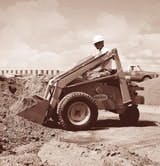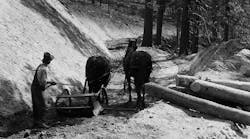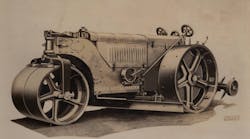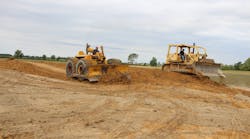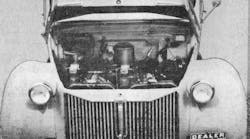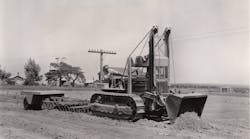It all started in the small town of Gwinner, N.D., where E.G. Melroe founded the Melroe Manufacturing Co. in 1947. For several years, the firm made small farm implements, including a grain-harvesting attachment and a spring-tooth harrow. In 1958, Lester Melroe (one of the founder's four sons), who by then was running the company, saw great potential in a new machine he was invited to see. It was a lightweight wheel loader specifically designed to clean manure from local turkey barns, and it was built by brothers Cyril and Louis Keller in their Minnesota machine shop. The machine had replaced uncooperative workers who often quit when it came time to clean out the barns by hand with pitchforks. Although the machine needed several modifications for outside work, the Melroe brothers subsequently purchased the manufacturing rights and employed the Keller brothers to build more machines.
The original Keller Loader was a three-wheeled machine powered by a 6-horsepower rope-start engine. Its main advantage was superior mobility made possible by its front-wheel drive and a caster wheel at the rear. In 1958, after a number of improvements, Melroe introduced its first loader, known as the "Melroe Self-Propelled Loader model M60." It was quickly succeeded by an improved version, the M200, with a more robust lift-arm assembly and an updated two-cylinder, air-cooled gasoline engine developing 12.9 horsepower.
In 1960, the three-wheel design was dropped in favor of a four-wheel-drive loader, the M400, which employed the skid-steer principle. Retaining the same engine as the former model, the M400 weighed 2,000 pounds. Although rubber-tired skid-steer machines had already been utilized on larger wheel dozers (LeTourneau), and one or two small but unsuccessful prototype loaders had been built, the Melroe M400 is considered the forerunner of today's skid-steer loader, and first of a new class of compact equipment.
In 1962, Melroe launched the M440 with operating weight upped to 3,285 pounds, and a larger gasoline engine of 15.5 horsepower. It was a more durable machine resulting from experience in the field and represented a total redesign of the M400. 1962 was also the year that Melroe adopted the name "Bobcat" for its loaders.
Over the years, further changes and refinements brought improvements and increased safety to Bobcat loaders. As far back as 1970, Melroe introduced its exclusive "Bob-Tach" quick-coupler attachment system, enabling the loader to be transformed quickly and effortlessly into a multi-job machine. Now skid steers operate with post hole augers, trenchers, graders, hammers, vibratory compactors, pallet forks and brooms. Rubber tracks have even been added to this versatile machine for some applications. In 2001, Bobcat was the first in the industry to market an all-wheel-steer plus skid-steer capability to a loader. Today's skid steer loaders are highly sophisticated, boasting joystick controls, hydrostatic drive and supreme comfort for the operator.
In 1969, the Melroe family sold their company to Clark Equipment of Buchanan, Mich. Ownership then passed into the hands of Ingersoll-Rand in 1995. In 2007, Doosan Infracore International, a U.S.-based subsidiary of Doosan Infracore, purchased Bobcat. Throughout these changes, the Bobcat product never lost its name or direction.
Click here for more information
Read more about Bobcat history in the new illustrated company book now available from www.bobcatstore.com or learn more about other construction equipment in Keith Haddock's fully illustrated book, Earthmover Encyclopedia available in bookstores. Also, consider a membership in the Historical Construction Equipment Association, www.hcea.net. Visit ConstructionEquipment.com for past Iron Works features.

